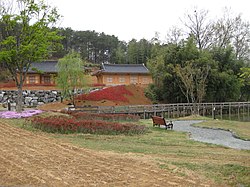Damyang 담양군 | |
|---|---|
| Korean transcription(s) | |
| • Hangul | 담양군 |
| • Hanja | 潭 陽 郡 |
| • Revised Romanization | Damyang-gun |
| • McCune-Reischauer | Tamyang-gun |
 | |
 Location in South Korea | |
| Coordinates: 35°19′08″N126°59′02″E / 35.3189°N 126.9839°E | |
| Country | |
| Region | Honam |
| Administrative divisions | 1 eup, 11 myeon |
| Area | |
• Total | 455.09 km2 (175.71 sq mi) |
| Population (September 2024 [1] ) | |
• Total | 44,800 |
| • Density | 121/km2 (310/sq mi) |
| • Dialect | Jeolla |
Damyang County (Damyang-gun) is a county in Jeollanam-do, South Korea. Tourism is a major local industry. Notable local products include bamboo goods and strawberries.
Contents
- Geography
- Mountains
- Flora
- Bamboo
- Metasequoia
- Culture
- Food
- Literature
- Events
- Dramas
- Landmarks and Monuments
- Temples
- Soswaewon
- Juknokwon
- Gwanbangjerim
- Sister cities
- See also
- References
- External links
Damyang is not to be confused with Danyang, which is located in eastern North Chungcheong Province.







